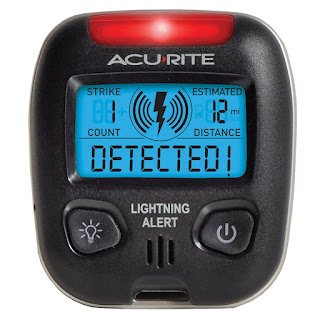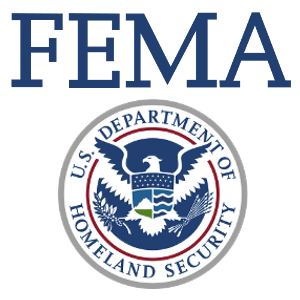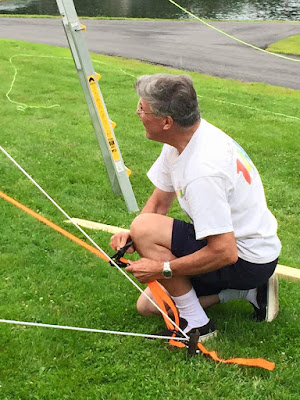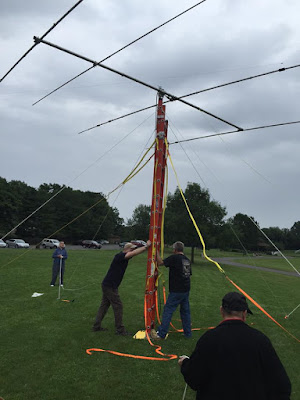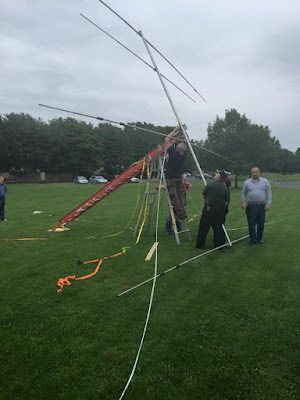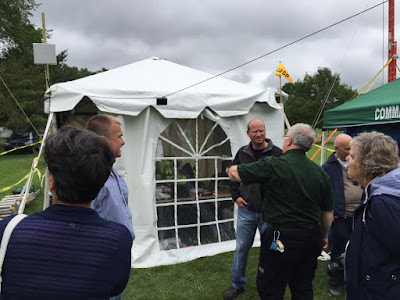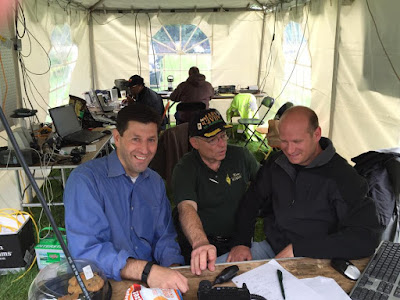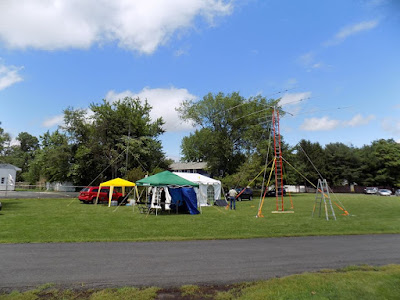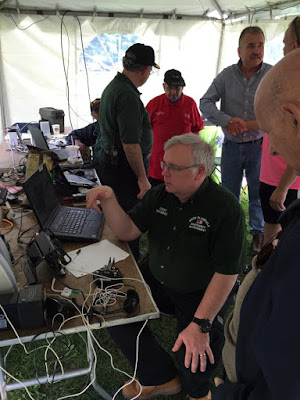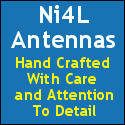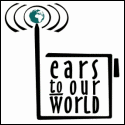Posts Tagged ‘preparedness’
 Exploring Shortwave Radio Signals: A Peek into Non-Local Communications
Exploring Shortwave Radio Signals: A Peek into Non-Local Communications
Curious about what you can hear on shortwave ham radio? This video is a brief survey of the diverse world of communications on the shortwave spectrum. Expand your radio horizons and enhance your emergency communication preparedness by tuning in to the world of shortwave ham radio.
If you’ve started delving into radio communications beyond local stations and channels, like VHF and UHF, you’re in for a treat. Shortwave radio opens up a whole new realm of signals to explore, including emergency communications vital during natural disasters.
Shortwave radio covers a range of radio frequencies from 3 kHz to 30 MHz. This spectrum is home to a diverse array of radio signals that cater to various communication needs, making it a hub of activity and connectivity.
Within these high frequencies, you can tune in to a multitude of transmissions, from transoceanic air traffic control communications to the chatter of ships navigating the vast seas. Imagine hearing the voices of fishermen, much like those on your favorite reality TV shows about high-seas fishing adventures, along with military communications and the vibrant world of amateur radio enthusiasts.
One of the remarkable features of high-frequency (HF) radio is its ability to propagate signals over long distances, transcending line-of-sight limitations. This means that HF radio enables communication between different regions and even continents, fostering connectivity across vast distances.
During times of crisis and natural disasters, shortwave frequencies become invaluable for emergency communications. When local infrastructure falters or is disrupted, shortwave radio serves as a vital lifeline, facilitating critical two-way communications in and out of disaster-stricken areas.
Explore the fascinating realm of shortwave radio, where distant voices blend with essential information, bridging gaps and connecting communities in times of need. Uncover the power of HF radio to transcend boundaries and provide lifelines when they are needed most.
In this video, I give you a glimpse of the voice and data transmissions I pick up on my high-frequency amateur radio transceiver (in this video, an Icom IC-7000). In later videos, I will dive deeper into specific types of HF communications, such as aeronautical trans-oceanic signals.
 Another D Day Special Event
Another D Day Special Event
 Long night
Long night
Description:
This class is designed for those auxiliary emergency communicators and groups who volunteer to provide backup emergency radio communications support to public safety agencies. Typically, this includes amateur radio and Radio Emergency Associated Communications Team (REACT) communicators, but may include other volunteer emergency communicators.
Volunteer emergency communications operators/groups, using amateur radio, have been providing backup communications to public safety for nearly 100 years. Event planners, public safety officials, and emergency managers at all levels of government utilize their services. Often, amateur radio services have been used when other forms of communications have failed or have been disrupted. Today, nearly all the states/territories have incorporated some level of participation by amateur radio auxiliary communication operators into their TICPs and SCIPs.
This course focuses on auxiliary communications interoperability, the relationship between the COML and the volunteer, emergency operations center (EOC) etiquette, on-the-air etiquette, FCC rules and regulations, auxiliary communications training and planning, and emergency communications deployment. It is intended to supplement and standardize an operator’s experience and knowledge of emergency amateur radio communications in a public safety context.
It's a two day event, held over the weekend of October 24th and 25th at the Middlesex County Fire Academy. Looks to be interesting. My registration was received and accepted pending my sending in the certificates of completion, which I sent in this morning.
The FEMA courses were comprehensive in scope. Each was designed to be completed in about 3 hours and I came in slightly under that amount of time - maybe two and a half hours or two hours and forty five minutes each.
I crammed two in last night (which wasn't wise) as each evening for the rest of this week is booked with other activities. I was pretty bleary eyed for that last exam, but was pleased when I got the e-mail that I passed.
FEMA offers a lot of free, on-line independent study courses. You can look them up at https://training.fema.gov/is/crslist.aspx?all=true
72 de Larry W2LJ
QRP - When you care to send the very least!
 Field Day 2015 – Comprehensive Report
Field Day 2015 – Comprehensive Report
First - set up the antennas, and organize the tent - our "home" for the next 24+ hours.
 2014 SET
2014 SET
 There is a season, turn, turn, turn
There is a season, turn, turn, turn
A time for W2LJ to ponder and to vent. This is stuff I’ve been thinking over the past couple of days. I can’t speak of these things to “civilians” as they would look at me like I was speaking in tongues (Ham speak?), not comprehending a word that I was saying.
The first occurred the other night as I was walking Harold, our beagle. As usual, I take my dual band HT with me and scan the various repeaters that I have programmed in there. The HT settled on a local VHF repeater that was holding an NTS Traffic Net. Having been a avid traffic handler in my early days as a Ham, I don’t mind listening in on these – procedures haven’t changed so much in all these years. At least I thought not.
The repeater itself was having problems. Some kind of interference or intermod was making communications difficult at best, almost impossible at worst. Two stations were having difficulty passing a couple of messages due to the interference. The receiving station asked the sending station to send him the messages via e-mail, and then he would deliver them. He told the Net Control Station to consider them passed traffic. Passed traffic?!? Would that be proper? Would that be considered the equivalent of going to another repeater or simplex frequency and passing them on the air? I applaud the ingenuity of the two stations, but ultimately passing traffic via a means that was not “radio” has me wondering if those could rightfully be counted as passed traffic. I may be a bit behind the current standards, so – anyone out there know if this would be considered Kosher?
When you get right down to it, I would think (IMHO) that traffic nets are supposed to be the resource available when everything else has turned to deep doo-doo. In that event, there will be no Internet to fall back on. IMHO, the two stations should have exhausted every RF means possible before resorting to e-mail and the Internet. But again, I may be just an old curmudgeon who’s behind the times and isn’t up to current standards. Can anyone shed a little light on this?
Secondly, the next scenario has to do with the QRP Fox Hunts. No calls will be used to protect the innocent and the not-so-innocent. We have been very fortunate to get some new blood showing up in the hunts. New-to-Fox-Hunting Hams have been showing up to participate both as Hounds, as well as Foxes. This is a very good thing, because if there’s no influx of new people, then sooner or later, the “sport” is going to die out. That would be a bad thing, as these are so much fun.
Anyway, a week ago we had a Ham perform his first ever shot at being Fox. I’ve been there, so I know what he faced. Believe me, for an experienced Fox it can be daunting, let alone your maiden voyage. The Hunt begins and close to, if not more than, a hundred Hounds are calling you all at the same time. A wall of barking, and they’re all barking at you. No amount of “Here’s what to expect” from an experienced Fox can really prepare you. It’s truly a “deer in the headlights” moment for most newbies (myself included).
Here’s the rub – it was an 80 Meter hunt, and according to Da Rulez, “The 80M Foxes will operate within +/- 10Khz of 3.560 MHz”. Well, the newbie Fox got distracted, excited, or maybe just a bit overwhelmed and planted himself just a hair above 3.570 MHz – less than 600 Hz away from the boundary. As it was, 42 Hounds found the Fox and snared his pelt. So it’s not like we’re talking that he was so far out of bounds that everyone was left mouth agape, wondering “Huh?”.
When he posted his log, he apologized for his error, and basically stated that this would not be repeated next time. Needless to say, that’s not good enough for some. Let’s just say that some of the responses were not exactly friendly, kind, understanding, encouraging or constructive. Here we get a volunteer to subject himself to a pileup of QRPers for 90 minutes and because you didn’t think to look outside the box, you let the poor guy have it! Nice ….. really nice!
Did he break the rules? Yes. Did he realize his error and apologize? Yes. Is this a cause for making someone feel like a schmuck? Definitely NO!
It’s not like we’re talking of a deliberate act, like interference or jamming, or being a willful idiot. The guy made a one time mistake, apologized for it and intends to do better the next time. I’ll be the first to admit, that in the past, I too may have been hot headed at times and may have been more than willing to jump on the pile with harshness. But due to some of my reader’s comments to me on some of my own blog postings (when I’ve been harsh), I feel that I have learned and have come to realize that this is not the right thing to do. Constructive criticism is the best way to go, and we need to cut the poor guy a break. Otherwise, we’re going to scare off volunteers and you’re going to find yourself hunting a Fox that’s literally not there (never mind just a little off frequency!)
72 de Larry W2LJ
QRP – When you care to send the very least!
 Getting ready for the next one.
Getting ready for the next one.
Sandy’s visit through the area has taught me a lot. I thought I was prepared; and for the most part, I was. But things can always be improved upon – some points for me to remember, that I think are worth sharing:
1) You can’t have enough ice. If you don’t have / want / or use an emergency generator, you can’t have enough ice. I bought four huge bags last Sunday, the day before the storm hit. I could have used twice that – and I should have been making my own, filling plastic containers with water and sticking them in the freezer. As it was, after the third day, I had begun to run out of ice and all the perishable items in the refrigerator had to be tossed.
2) Generators. Lots of folks purchased generators after their experience with Hurricane Irene last year. That was fine until the gas ran out, then they were in the same boat as me. Most of the gas stations around here had plenty of fuel, but also lacked the electricity they required to pump it. I have ordered an 1100 Watt AC inverter that was mentioned in SolderSmoke and I am going to purchase a couple deep cycle marine batteries and a charger. Once I start using them after a power outage they may not last for long, but at least I will be able to power up the freezer and refrigerator for a while.
Related to this – if you know that a big storm or blizzard is headed your way – gas up those vehicles! All of them! You don’t know how long gasoline might be in short supply afterwards. Go and Google “long New Jersey gas lines after Sandy” if you want a dose of stark reality.
3) Candles. You can never have too many. I thought I had an adequate supply; and I did. Our power was out for close to five days. If it had been out much longer, I would have started to reach the “uncomfortable zone” of running out. Oh, and if you’re like me, make sure your emergency candles are the unscented variety. It might have lifted someone else’s spirits; but I didn’t need the house smelling like a flower shop.
4) Flashlights. Forget the big honker ones that use “D” batteries. I bought some “D” batteries and flashlights, and they are a waste as far as “bang for the buck” goes. I have purchased two LED camping style lanterns that use four “D” batteries each and they will last a lot longer while providing tons more light than normal flashlights. For regular flashlight usage, get the small handheld LED flashlights. I had two of them and am going to get more. Each of these babies used three “AAA” batteries which are still plentiful in the stores (I mean really, most people use “AAA’s” for their remotes, right?). They were used throughout this crisis and they were as bright on the final day as the first. Also, those headband LED lights? Some may consider them “dorky”, but I am going to purchase a few. They will be invaluable for the times you have to do something in the dark that requires both hands. (I.E. – shaving on the morning darkness with one hand holding the safety razor and the other holding the flashlight was less than ideal. Trying to move ice around from cooler to freezer with one hand – less than ideal).
5) Firewood / Fire logs. I had a small supply left over from the last heating season. I should have laid in a bigger supply. I didn’t run out; but was running uncomfortably low, and it was starting to get chilly here. I would wake up in the morning, and go look at the thermostat to see that the house temperature had fallen to 56F (13C) overnight.
6) Charge up everything! All my handhelds, HF radio batteries, cell phones were charged to the max ahead of time, I also broke out my solar panel and had it ready to charge up 12V gel cells if needed as this wore on.
Food and water were no problem We had the stove top available for cooking. The electronic ignitors didn’t work; but kitchen matches did the job (I have multiple boxes of those). We had an AM / FM radio for news/entertainment. That was a necessity – however, I want to purchase one of those offered with the built in hand crank generator. This will cut down on the amount of batteries needed and many of these models also have USB ports so that you can use the hand crank generator to charge up your cell phone, kindle, Nook, Kobo, etc.
What did bother me when we would listen to the radio; and the announcers would say, “To report (such and such) please go to this Website ……..” How the heck am I supposed to go to the Internet when there’s no electricity? Also, going through my e-mails after the fact yesterday, I saw there were calls for ARES radio volunteers at the Middlesex County hospitals. The requests came via e-mails. How was I supposed to have seen those? I am one of the last persons in the world NOT to have a smartphone and my “18th century” cellphone handles e-mail, well, …… let’s just say “crappily”. Maybe that’s just a personal problem and I need to get “with it”. Not going to sweat that one for now.
The KX3 was invaluable and a God send – thank you Lord, for Elecraft! But seriously, any battery powered HF rig (PFR3, ATS, MTR, Yaesu FT-817, etc) is so essential if for nothing more than to ward off boredom. I would come home after work, eat dinner and then ………. nothing. Too early to turn in, I took afore mentioned LED flashlight and headed down to the basement shack and spent the night on the bands. I worked a fair amount of DX and even had a QSO with DL3GA who commented that “It is nice to hear a station on the air from New Jersey”. Hey, how many times have you heard THAT before? Maybe, never? (LOL!)
But I was also able to keep in touch with a lot of my QRP friends, including Jim W1PID who would check in with me every night. Just those brief, continual QSOs did a lot to improve my psyche and moral, knowing that there were folks out there that I personally knew that I could stay in touch with.
This is by no means an exhaustive treatise on being prepared for an emergency – it was one of some personal observations. But do yourself a favor. If you’re given enough notice that a big storm / blizzard / whatever, is coming your way – get ready and try not to wait until the very last moment to do so!
72 de Larry W2LJ
QRP – When you care to send the very least!

